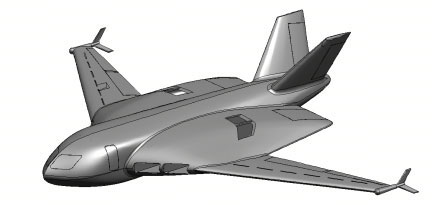Student team wins NASA's future aircraft undergraduate competition

A team of six undergraduate aerospace engineering students from Virginia Tech earned first place honors with their entry of STINGRAE in the 2008 NASA Aircraft Design Competition sponsored by NASA's Aeronautics Research Mission Directorate's Fundamental Aeronautics Program, part of the agency's Aeronautics Research Mission Directorate.
The six College of Engineering students were
- Bakar Bey of Richmond, Va.;
- Michael Fifer of Bristol, Va.;
- Jon Frankenfield of Virginia Beach, Va.;
- Michael Lurie of Chapel Hill, N.C.;
- Stephen Pace of Blacksburg, Va.; and
- Cabin Samuels of Burke, Va.
They were advised by Yan-Yee Andy Ko who worked as an adjunct faculty member in the aerospace and ocean engineering department at Virginia Tech.
The students’ entry into the competition was part of a two-semester senior aircraft design course for graduating seniors.
"The invention, imagination and engineering exhibited in these college proposals was extraordinary, and in parts superior to the concepts prevalent in the current professional literature. These entries bode well for the future of civilian aeronautics," said Dennis Bushnell, chief scientist at NASA's Langley Research Center in Hampton, Va. Bushnell was one of several NASA experts who judged the competition.
“The goals of my aircraft design course included showing the students how different engineering disciplines relate, that design requires compromise, and good engineering is a result of solid analysis. I am proud of this team. Their pragmatic, yet visionary solution clearly covered all the components of the course,” Ko said. Ko works as an aircraft design engineer at AVID LLC, an aircraft design services and software company with an office at Virginia Tech’s Corporate Research Center.
AVID also supported this project with both resources and engineering.
Aerospace and Ocean Engineering Department Head Christopher Hall, added, “The STINGRAE design combines several novel engineering approaches to address the problems of noise, pollution and efficiency. The team’s success reflects the vehicle design philosophy that is systematically developed throughout the aerospace engineering curriculum. Furthermore, this particular project demonstrates the synergy between the department and AVID Aerospace LLC’s Research Center. Students had the unique opportunity to engage AVID’s engineering staff in discussions and reviews of the design.”
Sixty-one students from 14 colleges and universities around the globe have imagined what the next generation of airliners and cargo planes may look like. Fourteen teams and two individual students submitted their designs in the annual contest.
The highest scoring graduate team was from Georgia Tech in Atlanta.
The contest asked students to create a future subsonic transport aircraft that could carry up to 50,000 pounds, operate on runways between 1,500 and 3,000 feet and cruise at speeds between 595 and 625 mph -- about the average speed of airliners today. The competition also stressed that concept planes should use alternative fuels and be quieter and more environmentally friendly than today's commercial fleet.
"The nation's air transportation system is under tremendous pressure to increase performance and capacity without causing additional damage to the environment," said Juan Alonso, director of the Fundamental Aeronautics Program. "Through competitions such as this, we are nurturing a new generation of engineers who can deliver the solutions we so desperately need."
The judges graded the designs on criteria including creativity and imagination, feasibility and cost analysis, and comprehensive discussion of design concept.




.jpg.transform/m-medium/image.jpg)